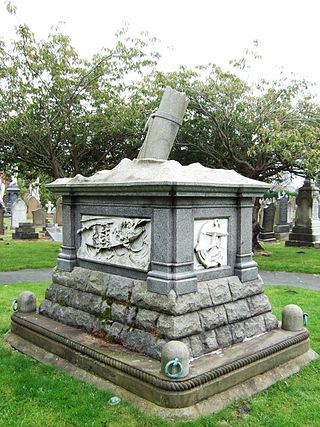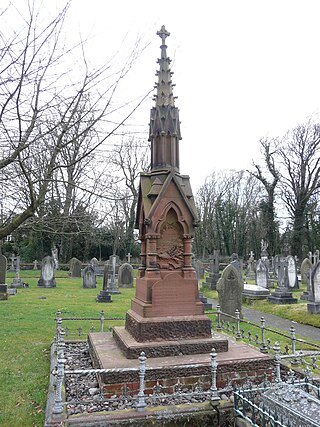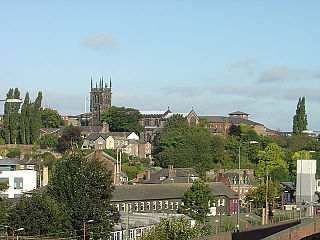
Widnes is an industrial town in the Borough of Halton, Cheshire, England, on the north bank of the River Mersey where it narrows at Runcorn Gap. The town contains 24 buildings that are recorded in the National Heritage List for England as designated listed buildings. Of these, 5 are classified at Grade II*, and the rest are at Grade II; Widnes has no Grade I listed buildings. In the United Kingdom, the term "listed building" refers to a building or other structure officially designated as being of special architectural, historical, or cultural significance. Listed buildings are categorised in three grades: Grade I consists of buildings of outstanding architectural or historical interest; Grade II* includes particularly significant buildings of more than local interest; Grade II consists of buildings of special architectural or historical interest. Buildings in England are listed by the Secretary of State for Culture, Media and Sport on recommendations provided by English Heritage, which also determines the grading.

Christ Church is a redundant Anglican church in Great King Street, Macclesfield, Cheshire, England. It is recorded in the National Heritage List for England as a designated Grade II* listed building, and is under the care of the Churches Conservation Trust. It is open to visitors at advertised times. The church was in use until 1981. It remains consecrated and is used occasionally for services.
Alfred Gatley was an English sculptor.
Cuddington is a civil parish in Cheshire West and Chester, England. It contains 15 buildings that are recorded in the National Heritage List for England as designated listed buildings, all of which are listed at Grade II. This grade is the lowest of the three gradings given to listed buildings and is applied to "buildings of national importance and special interest". In the parish are two villages, Cuddington and Sandiway, which are contiguous. The architect John Douglas was born in the village of Sandiway, and seven of the buildings in the list were designed by him, including the village church and its lychgate.
Moulton is a civil parish in Cheshire West and Chester, England. It contains three buildings that are recorded in the National Heritage List for England as designated listed buildings, all of which are at Grade II. This grade is the lowest of the three gradings given to listed buildings and is applied to "buildings of national importance and special interest". The listed buildings all date from the 19th and 20th centuries.
There are over 20,000 Grade II* listed buildings in England. This page is a list of these buildings in the unitary authority of Cheshire East.
The railway town of Crewe in Cheshire, England, contains 34 buildings recorded in the National Heritage List for England as designated listed buildings. Each is at Grade II, the lowest of the three gradings given to listed buildings, and applied to "buildings of national importance and special interest". Until the Grand Junction Railway established a railway station in 1837, Crewe was a "tiny township with a few farms". There are only two listed buildings dating from before the arrival of the railway: a much altered farmhouse that probably originated in the 16th century and a timber-framed farmhouse dating from the late 17th century. In 1842 the locomotive works opened, and Crewe had become an important railway junction, with lines coming from Birmingham and the south, and then going on to Chester, Manchester, and Liverpool. Houses were built to accommodate the railway workers. Most of these have been demolished, but some have survived and have been listed; these are in Betley, Dorfold, Tollitt, and Victoria Streets. There is also a surviving manager's house at 47 Delamere Street.

Crewe War Memorial stands in the Municipal Square, in Crewe, Cheshire, England. It consists of a bronze sculpture of Britannia standing on a pedestal, itself on a square base. The sculptor was Walter Gilbert and the sculpture was cast in the foundry of H. H. Martyn & Co. It was unveiled in 1924. The names of those killed in both world wars and in later conflicts are inscribed on bronze plaques around the base, and there are further inscriptions on the paving around the memorial. It originally stood in Market Square and was moved to Municipal Square in 2006. The memorial is recorded in the National Heritage List for England as a designated Grade II listed building.

Macclesfield Cenotaph is a World War I memorial in Park Green, Macclesfield, Cheshire, England. It was unveiled in 1921, and consists of a stone pillar and pedestal and three bronze statues. One statue is that of a mourning female, and the others comprise Britannia laying a wreath over a soldier who had died from gassing, an unusual subject for a war memorial at the time. The memorial is recorded in the National Heritage List for England as a designated Grade II* listed building.

The Queen Victoria Monument stands in the centre of Hamilton Square, Birkenhead, Wirral, Merseyside, England. It is in the form of an Eleanor cross. The memorial was designed by Edmund Kirby, and was unveiled in 1905. It is recorded in the National Heritage List for England as a designated Grade II listed building.

The Monument to the Mersey Tunnel stands in Chester Street, Birkenhead, Wirral, Merseyside, England, near the western entrance to the Queensway Tunnel, one of the two Mersey Tunnels carrying roads under the River Mersey between Liverpool and the Wirral. It consists of shaft with a light on the top, and originally had the dual purpose of being a monument and of illuminating the entrance to the tunnel. It was designed by Herbert James Rowse, and was one of a pair, but the monument that was on the Liverpool side of the River Mersey no longer exists. The monument is recorded in the National Heritage List for England as a designated Grade II listed building.

The Monument to Captain John Francis Egerton stands in the grounds of the Oulton Estate, Little Budworth, Cheshire, England. John Francis Egerton died in 1846 as the result of injuries sustained in the First Anglo-Sikh War. The memorial was designed by George Gilbert Scott and William Bonython Moffatt, and is recorded in the National Heritage List for England as a designated Grade II* listed building.

The Port Sunlight War Memorial stands in a central position in the model village of Port Sunlight, Wirral, Merseyside, England. The founder of the village and employer of its residents, William Lever, was anxious to have a memorial to commemorate those of his workers who had been lost in the First World War. As early as 1916 he commissioned Goscombe John to design a war memorial, which was completed and unveiled in 1921 by two of his employees. It consists of a granite runic cross with bronze statues and reliefs and has the theme "Defence of the Realm". On the memorial are the names of all of the company's employees who died as a result of both World Wars. It is recorded in the National Heritage List for England as a designated Grade I listed building.

The Bootle War Memorial is in King's Gardens, Stanley Road, Bootle, Sefton, Merseyside, England. It was paid for partly by a grant from the local council, and partly by public subscription. The sculptor was Herman Cawthra, with assistance in the design from Hubert Ernest Bulmer, the borough's art director. The monument consists of a mother and child on top of an obelisk, which is surrounded by the figures of three servicemen. It was unveiled in 1922, and the names of those killed in the Second World War were added in 1948. The memorial was recorded in the National Heritage List for England as a designated Grade II listed building in 1986, and upgraded to Grade II* in 2018.

The Monument to Hugh, Earl Grosvenor, is in the graveyard of St Mary's Church, Eccleston, Cheshire, England. It commemorates the brief life of the only son of Hugh Grosvenor, 2nd Duke of Westminster, who died at the age of four. The monument consists of an enclosure in bronze around his grave, and incorporates three bronze figures. It was designed by Detmar Blow, possibly assisted by Fernand Billerey, and the sculptor was Emile Madeline. The monument is recorded in the National Heritage List for England as a designated Grade II listed building.
The Bluecap Memorial stands in the yard of the Cheshire Hunt Kennels in Kennel Lane, Sandiway, Cheshire, England. Bluecap was a Cheshire foxhound that was famous for winning a race against the hounds of Hugo Meynell of the Quorn Hunt in 1763. The memorial is in sandstone and consists of an obelisk standing on a plinth, with a brass plaque inscribed with a poem. It is recorded in the National Heritage List for England as a designated Grade II listed building.

The Lifeboat Memorial, Southport, occupies a central position in Southport Cemetery, Cemetery Road, Southport, Merseyside, England. It commemorates the death of 27 lifeboatmen from Southport and St Annes who were lost in the attempt to rescue the crew of the German barque Mexico that had been driven into a sandbank in a gale in 1886. The memorial is in the form of a tomb chest on a tall plinth with carving and inscribed panels. It is recorded in the National Heritage List for England as a designated Grade II listed building.

The Lifeboat Monument, St Annes, stands on South Promenade, St Annes, Fylde, Lancashire, England. It commemorates the death of 13 lifeboatmen from St Annes who were lost in the attempt to rescue the crew of the German barque Mexico that had been driven into a sandbank in a gale in December 1886. The lifeboat from Southport also lost 14 of its 16 man crew in the disaster. The monument depicts a lifeboatman looking out to sea and standing on a rock-like plinth. It is recorded in the National Heritage List for England as a designated Grade II listed building.

The Lifeboat Memorial, Lytham, is in the churchyard of St Cuthbert's Church, Lytham St Annes, Fylde, Lancashire, England. It commemorates the death of 27 lifeboatmen from Southport and St Annes who were lost in the attempt to rescue the crew of the German barque Mexico that had been driven into a sandbank in a gale in 1886. The memorial is in the form of a Gothic-style tabernacle with a crocketed pinnacle. It is recorded in the National Heritage List for England as a designated Grade II listed building.

Macclesfield is a town in Cheshire East, England. It was originally a market town, and was granted a charter in 1261. The medieval town surrounded a hilltop that contained the Church of St Michael and the marketplace. Industry came to the town in the 18th century following the building of the first silk mill by Charles Roe in 1743. This industry grew with the building of more mills, and of houses incorporating weavers' garrets on the top floor, with large windows to light them. The mills were initially supplied with power from horses, or from the River Bollin, which ran through the town. Later, steam power was introduced. Communication was improved by the building of the Macclesfield Canal, which was completed in 1831. The silk industry declined from 1851, industry in the town diversified, and most of the surviving silk mills were converted into other industrial purposes or for domestic use. During the 20th century, some of the buildings were cleared from the town centre, and housing estates were built on the periphery of the town.














